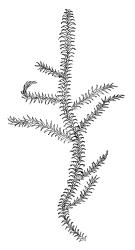Elements in the following description are taken from Rohrer (1985).
Plants coarse and robust, yellow-brown or green, dull or shiny, forming loose, often extensive and deep wefts. Stems creeping and ascendant at tips (decumbent), often quite elongate, irregularly and remotely branched to irregularly pinnate, in cross-section with thick-walled outer cells and a small central strand; branches acute or blunt, often decurved, sometimes with rhizoids near tips. Stem and branch leaves similar or ± differentiated. Stem leaves erect-spreading, squarrose, or falcate-secund, very broadly ovate to ovate-lanceolate, gradually to abruptly acuminate and the acumen sometimes channelled, sometimes cordate and sheathing at base, not decurrent, ± concave below, smooth throughout or plicate in lower half; margins plane throughout or narrowly reflexed at base, serrulate in upper ½ or more, serrulate to nearly entire below; mid laminal cells narrowly elliptic to linear, smooth or prorate, ± thin-walled, subporose; cells at insertion gold-brown, shorter, more incrassate, and more porose to form a band across the leaf base; alar cells weakly to strongly differentiated, typically shorter and wider than the basal cells or enlarged and pale in well-defined groups. Costae double, very short to c. ⅔ the leaf length. Paraphyllia absent. Pseudoparaphyllia broadly ovate to suborbicular (fide Rohrer 1985).
Dioicous. Perichaetia restricted to main stems, scattered, with leaves sheathing and squarrose-recurved above. Setae elongate, red-brown, smooth; capsules asymmetric, ± horizontal, ovoid to ellipsoid, smooth or furrowed when dry; exothecial cells isodiametric or short-rectangular; stomata superficial, restricted to capsule base; annulus differentiated; operculum conic, apiculate. Exostome teeth red-brown, lanceolate, shouldered, bordered; endostome yellow-brown, arising from membrane ⅓–½ the height of the teeth, with well-developed keeled and perforate segments and variably developed cilia. Calyptra cucullate, smooth.
A northern hemisphere genus of four species (Rohrer 1985). The species occurring in N.Z. are both clearly adventive.
| 1 | Stem leaves squarrose, distinctly sheathing the stem, not plicate, gradually tapered to a channelled acumen, c. 2.8–3.5 mm long; laminal cells prorate, weakly projecting on abaxial surface but not spinose; plants in N.Z. mostly female | R. squarrosus |
| 1' | Stem leaves wide-spreading, not sheathing the stem, plicate, gradually tapered to a non-channelled apex, c. 4.0–4.8 mm long; laminal cells strongly prorate-spinose on abaxial surface; plants in N.Z. male only. | R. triquetrus |
| Category | Number |
|---|---|
| Exotic: Fully Naturalised | 2 |
| Total | 2 |




